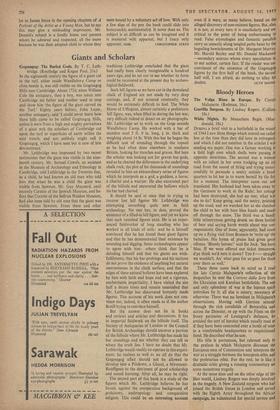Giants and Scholars
Gogmagog: The Buried Gods. By T. C. Leth- bridge. (Routledge and Kegan Paul, 21s.) IN the eighteenth century the figure of a giant cut in the turf, either inside Wandlebury Camp or close beside it, was still visible on the Gogmagog Hills near Cambridge. About 1724, when William Cole the antiquary, then a boy, was taken into Cambridge his father and mother used to stop and show him 'the figure of the giant carved on the Turf.' Eighty years before, John Layer, another antiquary, said 'I could never learn how these hills came to be called Gogmagog Hills, unless it were from a high and mighty portraiture of a giant wch the schollars of Cambridge cut upon the turf or superficies of earth within the said trench, and not unlikely might call it Gogmagog, which I have seen but is now of late discontinued.'
Mr. Lethbridge was impressed by two recent testimonies that the giant was visible in the nine- teenth century. Mr. Samuel Cowels, an assistant in the Museum of Archaeology and Ethnology in Cambridge, told Lethbridge in the Twenties that, as a child, he had known an old man who told him that when he was a child the giant was visible from Sawston. Mr. Guy Maynard, until recently Curator of the Ipswich Museum, and be- fore that Curator of the Saffron Waldon Museum, had also been told by old men that the giant was visible from Sawston. From these and other traditions Lethbridge concluded that the giant had really been clearly recognisable a hundred years ago, and he set out to see whether its form could be recovered at the present day by archaeo- logical fieldwork.
Such hill figures as we have cut in the downland chalk of England are not made by very deep cuttings, and, if not scoured constantly, they would be extremely difficult to find. The White Horse of Uffington, almost certainly a prehistoric hill figure, was, when filled in during the last war, very difficult indeed to detect on air photographs. Mr. Lethbridge set to work on the Gogs outside Wandlebury Camp. He worked with a bar of stainless steel 5 ft. 9 in. long, + in. thick and weighing about 14 lb. With this bar he began the difficult task of sounding through the topsoil as he had often done elsewhere in southern Britain, looking for trenches and graves. But here the scholar was looking not for graves but gods, and as he charted the differences in the underlying chalk rock, the plot of his thousands of soundings revealed to him an extraordinary series of figures which he interprets as a god, a goddess, a horse, a chariot and a warrior. He also excavated part of the hillside and uncovered the hollows which his bar had charted.
It should be said at once that in trying to recover lost hill figures Mr. Lethbridge was attempting something quite new in field archaeology. No one has, to date, proved the existence of a filled-in hill figure; and yet we know that such vanished figures exist. He is an exper- ienced fieldworker of long standing who has worked in all kinds of soils : and he is himself convinced that he has found these giant figures and that he has demonstrated their existence by sounding and digging. Some archaeologists appear to agree with him: others think that he is deluding himself and that his giants are wish- fulfilments, that his bar-probings and his sections do not prove the existence of anything but natural unevennesses in the chalk surface, and that the edges of these natural hollows have been explored by him with faith and hope and not a rigorous, uncharitable impartiality. I have visited the site half a dozen times and remain unsatisfied that Mr. Lethbridge has discovered humanly made figures. This account of his work does not con- vince me; indeed, it often reads as if the author is still trying to convince himself.
But the answer does not lie in books and reviews and articles and discussions. It lies in impartial fieldwork on the hillside itself. The Society of Antiquaries of London or the Council for British Archaeology should uncover a portion of the hillside where Mr. Lethbridge has made his bar soundings and see whether they can tell us where the truth lies. I have no doubt that Mr. Lethbridge would readily co-operate in this experi- ment; he realises as well as we all do that the Gogmagog affair should not be allowed to develop into a Piltdown, a Glozel, a Miremont- Rouffignac to the detriment of good scholarship and sound learning. After all, he may be right.
The second part of this book is a study of the figures which Mr. Lethbridge believes he has found, against the comparative background of prehistory, anthropology and comparative religion. This could be an interesting account even if it were, as many believe, based on the alleged discovery of non-existent figures. But, alas, it is not; at every turn it is unscholarly and un- critical to the point of being embarrassing to read. False etymologies and fantastic parallels carry us uneasily along tangled paths beset by the beguiling bewitchments of Dr. Margaret Murray, Mr. Harold Bayley and Mr. Donald Mackenzie —secondary sources whose every speculation is, to our author, certain fact. If the reader was un- convinced of the existence of the Gogmagog figures by the first half of the book, the second half will, I am afraid, do nothing to allay his






























 Previous page
Previous page